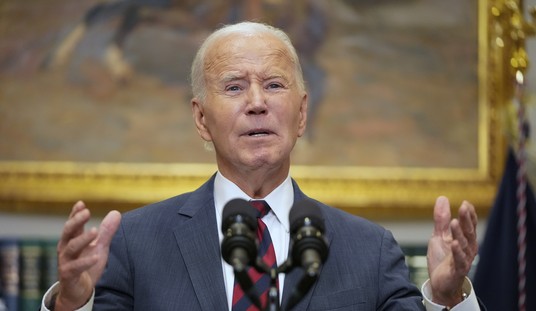Anyone who doubts the trend toward socialism is pushing America toward ruin should examine the historical tables President Obama published Monday along with his $3.7 trillion budget.
In fiscal 2011, according to these tables, the Department of Health and Human Services will spend $909.7 billion. In fiscal 1965, the entire federal government spent $118.228 billion.
What about inflation? According to the Bureau of Labor Statistics' inflation calculator, $118.228 billion in 1965 dollars equals $822.6 billion in 2010 dollars. In real terms, the $909.7 billion HHS is spending this year is about $87.1 billion more than the entire federal government spent in 1965.
1965 was a key year in the advancement of socialism in the United States.
From 1776 until 1965, Americans generally did not rely on the federal government for health care unless they served in the military or worked in some other capacity for the federal government.
But in 1965, President Lyndon B. Johnson and a Democratic Congress enacted two massive federal entitlement programs -- Medicare and Medicaid -- that fundamentally altered the relationship between Americans and the federal government by making tens of millions dependent on the government for health care.
Prior to 1937, the Supreme Court correctly understood the Constitution to deny the federal government any power to create and operate social-welfare programs. The Constitution held no such enumerated power, and the 10th Amendment left powers not enumerated to the states and the people.
From George Washington's administration to Franklin Roosevelt's, Americans took care of themselves and their own communities without resorting to federal handouts.
Recommended
FDR sought to change what he believed was an unrealistic reliance on families in American life.
He used the crisis of the Great Depression to pass the Social Security Act of 1935, compelling Americans to pay a payroll tax in return for the promise of a federal old-age pension. This was blatantly unconstitutional. That same year, in Railroad Retirement Board v. Alton, the Supreme Court had justly slapped down a law mandating what amounted to a Social Security program for the railroad industry alone.
FDR attempted to defend the railroad pension law as a legitimate regulation of interstate commerce, justifiable under the Commerce Clause -- the same argument the Obama administration has used to defend the individual mandate in Obamacare.
The Court scoffed, suggesting that if the federal government could mandate a federal pension for railroad workers, the next thing it would do would be to mandate health care.
"The question at once presents itself whether the fostering of a contented mind on the part of an employee by legislation of this type is, in any just sense, a regulation of interstate transportation," the Court said answering FDR's argument. "If that question be answered in the affirmative, obviously there is no limit to the field of so-called regulation. The catalogue of means and actions which might be imposed upon an employer in any business, tending to the satisfaction and comfort of his employees, seems endless. Provision for free medical attention and nursing, for clothing, for food, for housing, for the education of children, and a hundred other matters, might with equal propriety be proposed as tending to relieve the employee of mental strain and worry."
When Social Security went to the Court in 1937, FDR used a different strategy. He argued that Article 1, Section 8, Clause 1 of the Constitution, which gave Congress the power to levy taxes to "provide for the common Defence and general Welfare of the United States," meant the federal government could do virtually anything it deemed in the "general welfare" of Americans even if it was otherwise outside the scope of the Constitution's other enumerated powers.
FDR's interpretation of the General Welfare Clause effectively rendered the rest of the Constitution meaningless.
To persuade the same court that ruled against him in the railroad case to rule for him in the Social Security case, FDR proposed the Judicial Reorganization Act. This would allow him to pack the court by appointing an additional justice for each sitting justice who had reached age 70 and six months and not retired.
Faced with a potential Democratic takeover of the court, and thus a federal government controlled entirely by FDR's allies, Republican Chief Justice Charles Evans Hughes and Associate Justice Owen J. Roberts flip-flopped from their position in the railroad case. They quietly voted in favor of Social Security and took the steam off FDR's court-packing plan.
That year, federal spending was 8.6 percent of gross domestic product, according to President Obama's historical tables.
When LBJ enacted Medicare and Medicaid -- and began fulfilling the court's prophecy in the 1935 railroad-pension case -- federal spending was 17.2 percent of GDP.
When George W. Bush expanded Medicare with a prescription drug benefit in 2003, federal spending was 19.7 percent of GDP.
This year, federal spending will be 25.3 percent of GDP.
In 2014, when Obamacare is scheduled to be fully implemented, HHS will become the first $1-trillion-per year federal agency. That year, Medicare and Medicaid will cost $557 billion and $352.1 billion respectively, or a combined $909.1 billion -- about what all of HHS costs this year.
In other words, when Obamacare is just getting started, Medicare and Medicaid will cost more than the $822.6 billion in 2010 dollars than the entire federal government cost in 1965 when LBJ signed Medicare and Medicaid into law.

























Join the conversation as a VIP Member